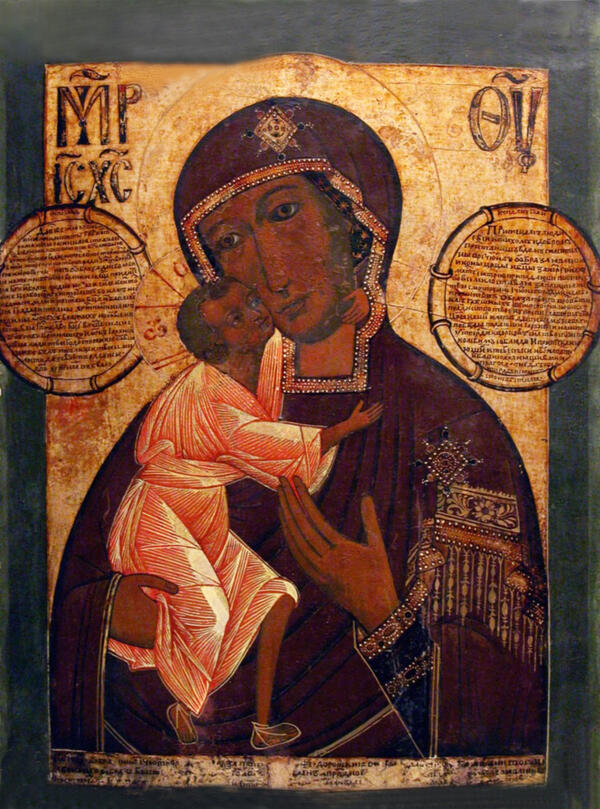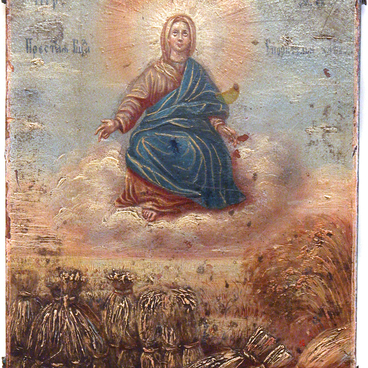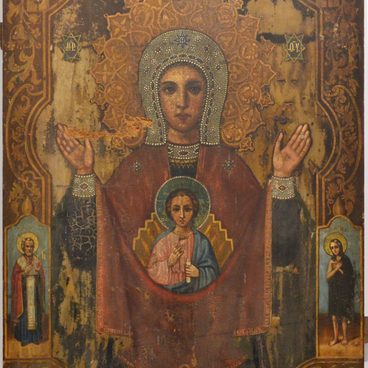Feodorovskaya Icon of the Mother of God is one of the most venerated icons in Russia. It’s historically considered the patron icon of the Romanov family, as it was an icon used for giving blessing to Mikhail Fyodorovich for his reign. Since the late 18th century all German princesses who married Russian princes adopted Orthodox Christianity. In honour of Feodorovskaya icon they got the patronymic name Fyodorovna. It’s remarkable that it must be the only icon which didn’t leave the church space after the expedition of People’s Commissariat of Education in 1919.
Since 1991 Feodorovskaya Icon has been in the Bogoyavlensky Convent in Kostroma. The iconographic type of the icon is the most ancient Eleusa type, where infant Jesus Christ is shown nestled against Mother Mary’s cheek. Eleusa means Tender Mercy. This image is the most lyrical one and, at the same time, the most bitter of all images of the Mother of God. There are a few legends on the appearance of the icon. Most probably it’s connected with prince Yaroslav Vsevolodovich’s commission. According to some sources, the title ascends to Theodore Stratelates, who was considered a patron of prince Yaroslav’s family. Feodorovskaya Icon of the Mother of God is a double sided icon. On the reverse side the image of saint martyr Paraskevi was placed. The researchers suppose that the appearance of this image was connected with Alexander Nevsky’s wife.
According to the specialists, another no less known relic Virgin of Vladimir lays in the basis of this iconography. But there’s a few special features here: The Christ’s left leg is bare up till his knee and bent, while in the icon of Virgin of Vladimir it’s stretched and covered with cloth. The uncovered leg is a symbol of future deadly sorrows of Christ. Also his heel is turned away from the viewer on the contrary with the one in the Vladimir’s icon.
This icon was made in early 19th century when the iconographical type was already known and copied a lot. On the background and the edges of the icon from the museum collection, to the left and to the right from the figures in medallions, are the texts of troparion and kondak. The icon lettering is doubled on a brassy cover with punching and engraving. The icon is based on the early examples, the Mother of God is severe and looks at her son with grief. The enveloping rope is dark and decorated with enamel ornament. The Christ’s clothes are, on the contrary, bright and are depicted with the help of bronze and golden tempera with empty spaces.
Since 1991 Feodorovskaya Icon has been in the Bogoyavlensky Convent in Kostroma. The iconographic type of the icon is the most ancient Eleusa type, where infant Jesus Christ is shown nestled against Mother Mary’s cheek. Eleusa means Tender Mercy. This image is the most lyrical one and, at the same time, the most bitter of all images of the Mother of God. There are a few legends on the appearance of the icon. Most probably it’s connected with prince Yaroslav Vsevolodovich’s commission. According to some sources, the title ascends to Theodore Stratelates, who was considered a patron of prince Yaroslav’s family. Feodorovskaya Icon of the Mother of God is a double sided icon. On the reverse side the image of saint martyr Paraskevi was placed. The researchers suppose that the appearance of this image was connected with Alexander Nevsky’s wife.
According to the specialists, another no less known relic Virgin of Vladimir lays in the basis of this iconography. But there’s a few special features here: The Christ’s left leg is bare up till his knee and bent, while in the icon of Virgin of Vladimir it’s stretched and covered with cloth. The uncovered leg is a symbol of future deadly sorrows of Christ. Also his heel is turned away from the viewer on the contrary with the one in the Vladimir’s icon.
This icon was made in early 19th century when the iconographical type was already known and copied a lot. On the background and the edges of the icon from the museum collection, to the left and to the right from the figures in medallions, are the texts of troparion and kondak. The icon lettering is doubled on a brassy cover with punching and engraving. The icon is based on the early examples, the Mother of God is severe and looks at her son with grief. The enveloping rope is dark and decorated with enamel ornament. The Christ’s clothes are, on the contrary, bright and are depicted with the help of bronze and golden tempera with empty spaces.



